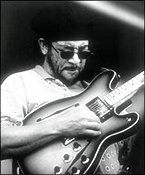Another Kind of Hip Hop
"The Kangaroo", Charles Sheffield, Excello 2205, 1961 
As you can probably tell, I love an odd, syncopated groove; and, this offering certainly delivers. Last month I posted another Charles Sheffield gem, “It’s Your Voodoo Working”, from the first of his of two Excello singles recorded by producer J. D. Miller [pictured] at his Crowley, Louisiana studio. As I said then, all four sides are excellent; but “The Kangaroo” from the second 45 may be the most exceptional of all due to the playing of drummer Clarence 'Jockey' Etienne.*
While it’s not all that complicated, the decidedly quirky drum pattern here is hard for me to explain, but definitely fun to hear and feel, with it’s off-the-beat snare hits and proto-funk push-push of the kick drum. An Afro-Cuban second line from the prairie of Southwest Louisiana, maybe? The Kangaroo dance may not have caught on with the hump-back demographic locally or nationwide, but the song sure makes me want to hunch over and do some kind of herky-jerky hop. As for the rest of the spare but effective instrumentation, tha's Katie Webster pounding the ivories; and, as with the previous Sheffield post, Lionel Prevost takes the raw sax solo. Dig Lazy Lester's scraper playing, too. * With Sheffield’s relaxed delivery of his strange tale about the dancing Quasimoto topping it off, this little groover is casual, loose and uniquely right, making it one of my favorite cuts ever to have emerged from the Texas/Louisiana Gulf Coast rhythm and blues scene. “The Kangaroo” can be found on the essential Ace (UK) CD compilation, Louisiana Roots: The Jay Miller R&B Legacy. So, get hip to it and get to hoppin’.
With Sheffield’s relaxed delivery of his strange tale about the dancing Quasimoto topping it off, this little groover is casual, loose and uniquely right, making it one of my favorite cuts ever to have emerged from the Texas/Louisiana Gulf Coast rhythm and blues scene. “The Kangaroo” can be found on the essential Ace (UK) CD compilation, Louisiana Roots: The Jay Miller R&B Legacy. So, get hip to it and get to hoppin’.
*[update 12/5/06] Many thanks to HOTG reader and music scholar, bbb, for verifying the musicians on this track. He got his information directly from Lazy Lester!












